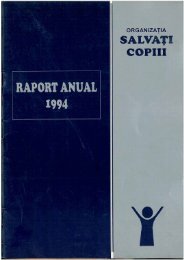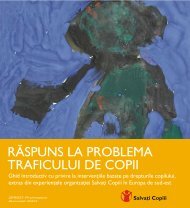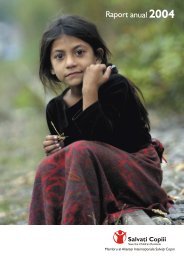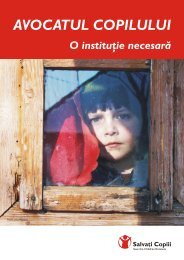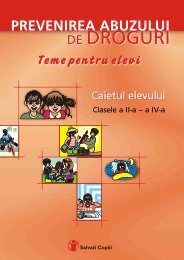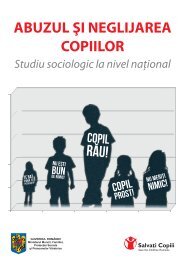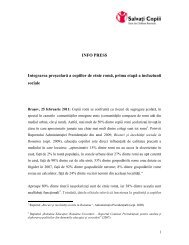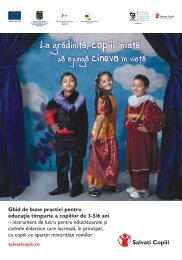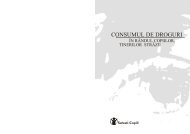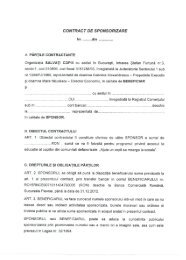Rights fRom the staRt - Salvati Copiii
Rights fRom the staRt - Salvati Copiii
Rights fRom the staRt - Salvati Copiii
Create successful ePaper yourself
Turn your PDF publications into a flip-book with our unique Google optimized e-Paper software.
<strong>Rights</strong> from<strong>the</strong> startEarly childhood careand education
2<strong>Rights</strong> From <strong>the</strong> Start: Early Childhood Careand Education was written by Vernor Muñoz,former United Nations Special Rapporteuron <strong>the</strong> Right to Education, on behalf of <strong>the</strong>Global Campaign for Education.
CONTENTSIntroduction: <strong>the</strong> Global Campaign forEducation’s vision for early childhoodcare and educationMessage from Irina Bokova, DirectorGeneral of UNESCOExecutive SummaryAcknowledgements4789I. The right to education and care inearly childhood: <strong>the</strong> conceptualframeworkII. Legal framework for early childhoodcare and educationIII. Early childhood care and education:progress and challengesIV. Good practice, case studies andtestimoniesV. Conclusions and recommendationsVI. Bibliography1013152934363
Introduction: <strong>the</strong> Global Campaign for Education’svision for early childhood care and educationThis report, by Vernor Muñoz, former UN SpecialRapporteur on <strong>the</strong> Right to Education, is intended - from<strong>the</strong> title onwards - to highlight a truth that should beuncontroversial: that nei<strong>the</strong>r rights nor educationbegins when a child first enters a primary school. On<strong>the</strong> contrary, as <strong>the</strong> Jomtien Declaration of 1990 affirms(and every parent knows), “learning begins at birth”,and every person, regardless of age, is entitled to <strong>the</strong>exercise of rights including <strong>the</strong> right to care andeducation. As <strong>the</strong> report sets out, early childhood careand education – especially for <strong>the</strong> most vulnerable anddisadvantaged – is included as ‘Goal 1’ of <strong>the</strong> sixEducation For All goals, agreed by 164 governmentsin Dakar in 2000, and is affirmed as an individual rightin numerous international and regional treaties. For <strong>the</strong>Global Campaign for Education, this clearly meansthat it is also a state responsibility, which requires astrong and coordinated government response.The right to early childhood care and education is,moreover, crucial to securing o<strong>the</strong>r rights (such asthose to health and civic participation), to helping individualsescape from poverty and fulfil <strong>the</strong>ir potential,and to helping combat inequality within and betweencommunities and nations. For example, The Lancet(one of <strong>the</strong> world’s leading medical journals) publishednew research in 2011 demonstrating that early childhood– which is generally understood to cover <strong>the</strong>period from birth to <strong>the</strong> age of eight – is <strong>the</strong> periodduring which quality care and education programmescan do most to “break <strong>the</strong> cycle of inequities that hasdominated <strong>the</strong> lives of millions of children and families”.And yet, if we examine government planning andbudgets, as well as donor assistance for developingcountries, it appears that <strong>the</strong> right to early childhoodcare and education and its inextricable links to o<strong>the</strong>rrights are not widely accepted. With some laudableexceptions, most governments still do not prioritise – oroften even include – early childhood in <strong>the</strong>ir educationstrategies or o<strong>the</strong>r national plans. Barely half of <strong>the</strong> countriesincluded in <strong>the</strong> UNESCO Global Monitoring Reporton Education For All are confirmed as having officialprogrammes which provide for children aged three oryounger, and many of <strong>the</strong>se reach only a minorityof children. Average regional spending on preprimaryeducation ranges from 0.5% of GDP in Central andEastern Europe to close to 0 in South and West Asiaand sub-Saharan Africa. The Committee on <strong>the</strong> <strong>Rights</strong>of <strong>the</strong> Child highlights that many states, in <strong>the</strong>ir reportsto <strong>the</strong> Committee, provide very little information aboutearly childhood, with comments limited mainly to childmortality, birth registration and health care.This report argues that <strong>the</strong> failure to recognise youngchildren as rights-holders is central to perpetuating<strong>the</strong>se gaps. Without a rights framework, <strong>the</strong> pressureon governments to meet <strong>the</strong>ir responsibilities is weakor lacking. This leads both to a relative dominance of<strong>the</strong> private sector in early childhood provision, creatinga cost barrier for <strong>the</strong> poorest and most vulnerable, andto a reliance on economic justification for providingearly childhood education, with dangerous implicationsfor <strong>the</strong> content and curricula of early childhood careand education as well as <strong>the</strong> distribution of provision.The Global Campaign for Education (GCE) is callingfor a transformation of this situation. Our membershave voiced strong support for a focus onearly childhood care and education, and in April2012, GCE members in more than 80 countrieshave been taking action to demand recognition of“rights from <strong>the</strong> start”. A full recognition of <strong>the</strong>serights will have a number of implications:4
xxxEvery child – including <strong>the</strong> most marginalised– should have <strong>the</strong> opportunity to accessearly childhood care and educationThis should be available, even if not all families chooseto make use of services outside <strong>the</strong> family. This willimply a considerable expansion of provision and amajor focus on inclusion of <strong>the</strong> marginalised, includingchildren with disabilities and special needs; groups atrisk of discrimination such as girls, ethnic, religious orlanguage minorities; children in conflict-affected states,and <strong>the</strong> poorest. More needs to be done to combat <strong>the</strong>situation in which, for example, <strong>the</strong> likelihood of a childfrom a poor household in Egypt accessing early childhoodcare and education is one twenty-eighth that ofa child from a wealthy household.Governments should ensure comprehensiveand integrated services for young children– including care, health and education –that are regularly monitored to ensure highquality.Given <strong>the</strong> primary responsibility of <strong>the</strong> family, thisshould encompass safe mo<strong>the</strong>rhood and parentingsupport programmes, as well as day-care and flexiblecare services, pre-schools, and <strong>the</strong> early years ofprimary school – when drop-outs and repetition canbe particularly high. A comprehensive approach willalso focus on <strong>the</strong> transition from pre-primary servicesto primary education.Curricula and approaches should meet <strong>the</strong>educational, developmental, nutritional,health and individual needs of children.They should be flexible, put <strong>the</strong> child at <strong>the</strong> centre andvalue all kinds of activities including, crucially, play: rigid,formal preschools that do not allow for play can be unpleasantfor children and damage <strong>the</strong>ir development.Teachers and o<strong>the</strong>r staff should betrained, qualified, supported and valuedprofessionals.States should offer upgrading programmes throughinstitutional arrangements for unqualified and underqualifiedteachers and caregivers, and improve payand conditions of service.A significant increase in financing is neededto provide <strong>the</strong>se services.There should also be clearer reporting of financinglevels to allow for greater accountability. It is recommendedthat countries dedicate at least 1% of GDP toearly childhood services, with a goal of at least 10% ofeducation budgets and similar amounts from healthbudgets. Donors need to significantly increase <strong>the</strong>ircontributions.5
xxxPublic policy and planning for earlychildhood care and education should bestronger and better coordinated, withproper oversight of private sector or NGOprovision.Governments should have a single, integrated earlychildhood policy, developed in <strong>the</strong> context of a nationalvision for young children. These plans should cover allrelevant ministries and agencies, but with clearresponsibility from a lead agency. Although <strong>the</strong> privatesector has taken a rapidly expanding role in manycountries, often this has not been well regulated, is notin <strong>the</strong> context of a national vision or plan, or is at <strong>the</strong>expense of states taking on <strong>the</strong>ir responsibilities.“There are 1 billion children agedunder eight years old in <strong>the</strong> world, morethan 10% of <strong>the</strong> world’s population. Theneglect of <strong>the</strong>se children’s rights –and <strong>the</strong> consequent impact on <strong>the</strong>iro<strong>the</strong>r rights, <strong>the</strong>ir opportunities and<strong>the</strong>ir societies – is too devastating tocontinue.”GCE’s more detailed campaign demands are presentedat <strong>the</strong> end of this report.There are 1 billion children aged under eight years oldin <strong>the</strong> world, more than 10% of <strong>the</strong> world’s population.The neglect of <strong>the</strong>se children’s rights – and <strong>the</strong> consequentimpact on <strong>the</strong>ir o<strong>the</strong>r rights, <strong>the</strong>ir opportunitiesand <strong>the</strong>ir societies – is too devastating to continue.The argument, <strong>the</strong> evidence and <strong>the</strong> demand fromfamilies, campaigners and experts are clear, and <strong>the</strong>Global Campaign for Education thanks Vernor Muñozfor making that so evident in this report. Now it is <strong>the</strong>turn of governments around <strong>the</strong> world to take action toensure <strong>the</strong> realisation of rights from <strong>the</strong> start.Global Campaign for EducationApril 20126
Executive Summary<strong>Rights</strong> from <strong>the</strong> start describes <strong>the</strong> long road thatpeoples around <strong>the</strong> world must travel in order torespect, protect and realise <strong>the</strong> right to <strong>the</strong> care andeducation of children during <strong>the</strong>ir early childhood.Even with <strong>the</strong> proposals to expand and improve thishuman right that are being made in different internationalforums, <strong>the</strong> obstacles remain significant and <strong>the</strong>efforts to overcome <strong>the</strong>m limited.The notion of “early childhood” has been created overtime, developing out of diverse and changing socioculturalperspectives. In recent centuries, this idea hasgained ground in defining universally what it means tobe a young child. This understanding, however, generallyexcludes girls and boys – especially <strong>the</strong> youngest – fromexercising <strong>the</strong>ir citizenship in <strong>the</strong> broadest sense of <strong>the</strong>term, which in turn limits <strong>the</strong> exercise of <strong>the</strong>ir rights.Early childhood education is included in <strong>the</strong> universalright to education clearly detailed in internationalhuman rights law.These international instruments have two commonaspects: first, <strong>the</strong> recognition, be it explicit or implicit,that learning begins at birth; second, <strong>the</strong> acknowledgementthat care and education in early childhoodare not disconnected, unrelated issues.Because of multiple factors (including <strong>the</strong> limiteddevelopment of relevant laws, <strong>the</strong> persistence of patriarchaland adult-centric attitudes, <strong>the</strong> influence ofinternational financing bodies on <strong>the</strong> definition educationpolicy, <strong>the</strong> subordination of education policies to marketneeds and a lack of political will on <strong>the</strong> part of governments)an understanding of early childhood educationas a human right has largely been superseded by aneconomic and utilitarian vision of education, based on<strong>the</strong> idea of creating “human capital”. Yet <strong>the</strong> conceptof early childhood care and education based on ahuman rights perspective is not only capable ofpreparing people for <strong>the</strong>ir future lives and buildingbetter economic conditions, it is also capable ofpromoting peace within communities and nations inorder to increase equity, stimulate social mobility andovercome poverty.A reductionist vision of early childhood educationovershadows <strong>the</strong> key stakeholders (<strong>the</strong> girls and boys<strong>the</strong>mselves) and prevents <strong>the</strong>m from becoming activeparticipants, by valuing <strong>the</strong>ir future over <strong>the</strong>ir present.This encourages significant structural imbalances,leading to <strong>the</strong> beginnings of exclusion and discrimination.Fur<strong>the</strong>rmore, it means that <strong>the</strong> cultural wealthand diversity intrinsic to <strong>the</strong> pedagogic process arereduced to simple mechanisms of accumulation.The report also reflects both <strong>the</strong> progress made andchallenges encountered in <strong>the</strong> realms of public policy,budget allocation, enrolment, teaching staff, genderequality, health and o<strong>the</strong>r key areas for early childhood.Whilst important advances have been achievedin <strong>the</strong>se areas, at times <strong>the</strong> change is excessively slowor inconsistent, leading to fur<strong>the</strong>r delays in recognizingchildren’s entitlement to all human rights, and thus<strong>the</strong>ir right to full citizenship during early childhood.The inclusion of examples of good practice (from Brazil,Pakistan and Senegal), allows us to examine innovativeinitiatives that adopt a holistic approach to earlychildhood care and education, yielding significantquantitative and qualitative results, measured in bothpolitical impact and structural change. However, <strong>the</strong>case studies also demonstrate serious limitations in<strong>the</strong> fulfilment of state obligations, such as limited budgetallocations, which lead to inadequate education infrastructure,equipment and specialist resources, amongo<strong>the</strong>r challenges.8
AcknowledgementsThe Global Campaign for Education would like to thankVernor Muñoz and Teresa Artega Böhrt for <strong>the</strong>ir hardwork on <strong>the</strong> writing of this report.The author is grateful for <strong>the</strong> generous supportprovided by <strong>the</strong> secretariat of <strong>the</strong> Global Campaign forEducation (GCE) during <strong>the</strong> preparation of this report.He also thanks <strong>the</strong> GCE working group for <strong>the</strong> 2012Global Week of Action on Early Childhood Care andEducation, along with <strong>the</strong> three coalitions that sharedmaterial for case studies: <strong>the</strong> National Campaign forEducation in Brazil, <strong>the</strong> Pakistan Education Coalitionand COSYDEP in Senegal. The author would also liketo acknowledge and thank <strong>the</strong> co-authorship of TeresaArtega Böhrt in preparing this report, and Peter Moss,for his important cooperation.9
Within a reductionist vision that relates education tohuman capital, <strong>the</strong>re are attempts to measure <strong>the</strong>impact and future benefits of early childhood development(ECD) programmes without considering <strong>the</strong>impact that education has in important areas includingethical and aes<strong>the</strong>tic capacities, participation in andenjoyment of community life, cultural identity and <strong>the</strong>valuing of o<strong>the</strong>r cultures, tolerance, equality, respectand enjoyment <strong>the</strong> environment 14 .Yet an understanding of early childhood care andeducation from <strong>the</strong> perspective of human rights cannot only prepare people for <strong>the</strong>ir future lives and buildingbetter economic conditions, it can also promotepeace within communities and nations so as to fomentequity, stimulate intergenerational social mobility andovercome poverty.many o<strong>the</strong>r factors. Simply following <strong>the</strong> laws of <strong>the</strong>market will not overcome <strong>the</strong>se structural obstacles:ra<strong>the</strong>r, <strong>the</strong>re is a need for new initiatives based onrespect for diversity and <strong>the</strong> exercise of <strong>the</strong> humanrights.Understanding of early childhood is built according todistinct worldviews, making it necessary to take interculturalisminto consideration. This notion should notbe reduced to inclusion of those social groups andpeople that have been historically excluded and discriminatedagainst; ra<strong>the</strong>r it is a process that facilitatesdialogue, respect and building real equality.However, before being able to imagine a “world ofequal people”, <strong>the</strong>re must be recognition of and actionaddressing inequality, discrimination and power.Early childhood care and education foments socialinclusion and gives people an education that supports<strong>the</strong>ir active participation in community life, <strong>the</strong>rebycontributing to <strong>the</strong> reduction of political instability andstreng<strong>the</strong>ning democratic stability. This is becauseschooling helps in teaching people to interact witho<strong>the</strong>rs and improves <strong>the</strong> benefits of civic participation,including voting and organisation 15 .Education in early childhood based on human rightsrequires giving attention to <strong>the</strong> needs and rights of <strong>the</strong>child on an individual basis; with clear benefits for <strong>the</strong>irfuture, though principally within <strong>the</strong> context of <strong>the</strong>ircurrent situation.This manner of viewing education also makes it possibleto address severe issues such as malnutrition, mortalityand child poverty, and enables understanding of <strong>the</strong>fact that exercise of <strong>the</strong> right to education is ofteninfluenced by poverty, by gender inequality, by placeof birth, by language, by ethnicity, by disability andEmbracing diversity as <strong>the</strong> focus of relations meansaccepting inter-culturalism and multi-culturalism as anew model for social organisation, in which <strong>the</strong>principles of social responsibility, active citizenship,empowerment, citizen participation and deliberativedemocracy are redefined and invigorated 16 . For example,we can begin by considering diversity and interculturalismin <strong>the</strong> development and implementation ofstate public policies regarding children during <strong>the</strong> firstyears of <strong>the</strong>ir lives.14 Convention on <strong>the</strong> <strong>Rights</strong> of <strong>the</strong> Child, Article 29.15 A Commitment to Universal Access to Early ChildhoodDevelopment Programmes.16 Magendzo, Abraham. International Conference “Evaluation andAccountability in Human <strong>Rights</strong> Education”. April 4, 2004. Citedin Muñoz, The River Between <strong>the</strong> Rocks.12
II. Legal framework for early childhood careand educationThe right to education is guaranteed in internationallaw through <strong>the</strong> majority of international human rightsinstruments. The Universal Declaration of Human<strong>Rights</strong> establishes that all individuals have <strong>the</strong> right toeducation. The International Covenant on Economic,Social and Cultural <strong>Rights</strong> reinforces this principle,making clear that education should be orientedtowards full human development and dignity, andshould enable people to participate effectively in a freesociety. The consideration of <strong>the</strong> best interest of <strong>the</strong>child and <strong>the</strong> elimination of stereotypes and prejudice ineducation is a central <strong>the</strong>me of <strong>the</strong> Convention on <strong>the</strong>Elimination of All Forms of Discrimination AgainstWomen (CEDAW) and of <strong>the</strong> Declaration on <strong>the</strong> <strong>Rights</strong>of Disabled Persons. The Convention of <strong>the</strong> <strong>Rights</strong> of<strong>the</strong> Child reaffirms this right, laying out <strong>the</strong> aims ofeducation and <strong>the</strong> state obligation to guarantee <strong>the</strong>survival and development of <strong>the</strong> child from a basis ofequal opportunities and inclusion of <strong>the</strong> most vulnerableor disadvantaged. This also reaffirms <strong>the</strong> right of childrento participate in decision-making regarding issues thataffect <strong>the</strong>m.These obligations have been clarified by <strong>the</strong> Committeeon <strong>the</strong> <strong>Rights</strong> of <strong>the</strong> Child in General Comments 7, 9,11 and 12. General Comment 7: Implementing Child<strong>Rights</strong> in Early Childhood confirms that young childrenhave all of <strong>the</strong> rights set out in <strong>the</strong> Convention. TheCommittee confirms that <strong>the</strong> right to ECCE begins atbirth, and is intimately linked to <strong>the</strong> right of <strong>the</strong> child to<strong>the</strong> maximum possible development as laid out inarticle 6.2 of <strong>the</strong> Convention. In this way, <strong>the</strong> Committeeaffirms that <strong>the</strong> maturing and learning processes bywhich children progressively acquire knowledge,competencies and an awareness of <strong>the</strong>ir rights, canonly happen holistically, through observance of all <strong>the</strong>Convention’s regulations. This includes <strong>the</strong> right tohealth, to nutrition, to social security, to an appropriatestandard of living, to a healthy and safe environment,to education and to play (articles 24, 27, 28, 29 and 31).In <strong>the</strong> same way, <strong>the</strong> responsibilities of parents mustbe respected, and quality services and assistanceoffered (articles 5 and 18).These Comments are based on <strong>the</strong> Committee’sexperience examining state reports, and recognise <strong>the</strong>significant contribution of <strong>the</strong> Millennium Declarationand <strong>the</strong> Millennium Development Goals (2000) and <strong>the</strong>‘A World Fit for Children’ declaration of <strong>the</strong> UnitedNations Special Session on Children (2002).The World Declaration on Education for All (Jomtien,1990) states that ‘learning begins at birth’, and <strong>the</strong>Dakar Framework for Action on Education For All(EFA), developed at <strong>the</strong> World Education Forum (2000),has as its first goal “expanding and improving comprehensiveearly childhood care and education, especiallyfor <strong>the</strong> most vulnerable and disadvantaged children”.Following on from <strong>the</strong> process begun in Jomtien,UNESCO organised <strong>the</strong> first global conference onearly childhood education in Moscow in 2010. Theresulting Action Plan recognised <strong>the</strong> difficulty ofachieving <strong>the</strong> first EFA goal by 2015, and urgedgovernments to develop concrete legislation, policiesand strategies; to increase access on a large scale; toboost analysis, monitoring and evaluation of this right;to improve <strong>the</strong> quality of programmes and to increase<strong>the</strong> resources and finances available to <strong>the</strong>se ends.In Africa, <strong>the</strong> right to early childhood care and educationis guaranteed in <strong>the</strong> African Charter on Human andPeople’s <strong>Rights</strong> (also known as <strong>the</strong> Banjul Charter), <strong>the</strong>African Charter on <strong>the</strong> <strong>Rights</strong> and Wellbeing of Childrenand <strong>the</strong> Cultural Charter for Africa.13
III. Early childhood care and education:progress and challengesThe progress and challenges examined in this reportfocus on <strong>the</strong> areas of public policy, budget allocation,enrolment, teaching staff, gender parity and equality,health and o<strong>the</strong>r areas of care for children in <strong>the</strong> earlyyears.Public policies, state plans and programmes:Limited governmental involvement in caring for <strong>the</strong>educational needs of children in early childhood is inpart due to <strong>the</strong> fact that, in many countries, <strong>the</strong> provisionof education starting from birth is not compulsory,and when it is provided it is only considered to be apreparatory stage for formal schooling.As previously noted, early childhood education islargely privatized 19 , particularly for <strong>the</strong> 0-3 years agegroup. Access to such programmes remains low indeveloping countries, particularly for children living inrural areas, or who have special educational needs 20 .None<strong>the</strong>less, ECCE is increasingly considered as apart of basic education, although it is not formallyintegrated into <strong>the</strong> education system in many countries.It is <strong>the</strong>refore more usual to find initiatives thatoperate without adequate resources or support. Fur<strong>the</strong>r,planning for early childhood education remains peripheral,and faces coordination challenges, leading tolost opportunities for many children 21 . Of <strong>the</strong> 204countries included in UNESCO’s Global MonitoringReport on education, in 2005 around half (104) werereported to have official programmes targeting childrenunder <strong>the</strong> age of 3; a fur<strong>the</strong>r 29 did not have suchprogrammes, whilst for 71 <strong>the</strong>re was no information 22 .The tendency of most governments to focus on girlsand boys above three years old means that youngerchildren are largely catered for by private institutions23. It is thus difficult to determine precisely how manychildren participate in ECCE programmes. Data suggests,however, that children older than three years ofage living in urban areas are twice as likely to access<strong>the</strong>se programmes as rural children, with <strong>the</strong> poorestquintile of <strong>the</strong> population finding itself largely excludedfrom such educational opportunities 24 . This type ofexclusion is linked to <strong>the</strong> absence of affirmativemeasures seeking to support families financially andsocially, as well as <strong>the</strong> need to make educationalservices more appropriate to <strong>the</strong> children’s social andcultural contexts.Although all European countries have adopted publicpolicies around ECCE, access to <strong>the</strong>se programmesvaries from country to country. During <strong>the</strong> BarcelonaSummit of 2002, EU member states recognised <strong>the</strong>importance of early childhood care for growth and equalopportunities, and consequently established goals forearly childhood care by 2010. They aimed to reach 33%of children under 3 years old, and 90% of children agedbetween 3 years and compulsory school age.19 UNESCO. EFA Global Monitoring Report. 2011. The hiddencrisis: Armed Conflict and Education. p. 3920 Education International. 2010. Early Childhood Education:a global scenario. 2010, p16.21 UNESCO. EFA Global Monitoring Report. 2011. The hiddencrisis: Armed Conflict and Education pp.38-39.22 UNESCO. EFA Global Monitoring Report. 2011. The hiddencrisis: Armed Conflict and Education.23 Gwang-Jo Kim, Mami Umayahara. Early Childhood care andeducation: building <strong>the</strong> foundation for lifelong learning ande <strong>the</strong>future of <strong>the</strong> nations of Asia and <strong>the</strong> pacific. International Journalof Child Care and Education Policity. 2010, Vol. 4, No. 2, 1-13, p. 7.24 UNESCO. EFA Global Monitoring Report. 2011. The hiddencrisis: Armed Conflict and Education , p.38.15
These goals were driven by <strong>the</strong> economic pressuresgovernments were facing, and by <strong>the</strong> fact that a highnumber of women were workforce participants 25 .However, <strong>the</strong> 2008 evaluation of progress towards<strong>the</strong>se goals revealed that only 7 states had achieved<strong>the</strong> 33% goal, and only 9 <strong>the</strong> 90% goal 26 .In <strong>the</strong> case of sub-Saharan Africa, ten countries hadadopted policies on ECCE by December 2008. Afur<strong>the</strong>r 20 were in <strong>the</strong> process of preparing policies,and 12 had not even begun <strong>the</strong> process. By 2010, 26countries had included ECCE in <strong>the</strong>ir developmentplans 27 , in <strong>the</strong> context of action plans which have threelevels: a) awareness-raising for families and communitiesabout <strong>the</strong>ir responsibilities concerning ECCE, b)improving access to and use of ECCE services, and c)integrating ECCE into national development plans andprogrammes 28 .Many countries in <strong>the</strong> region have curriculum proposalsthat apply from <strong>the</strong> first few months, yet <strong>the</strong> tendencyis to only apply <strong>the</strong>m from 3 years and above 29 .To comply with <strong>the</strong> regulatory framework surrounding<strong>the</strong> Convention on <strong>the</strong> <strong>Rights</strong> of <strong>the</strong> Child, public policieson early childhood must pay attention to a child’ssurvival, development, participation and protection.However, given that for <strong>the</strong>se children <strong>the</strong> most immediateenvironment in which <strong>the</strong>y survive, develop,participate and are protected is <strong>the</strong> family 30 , <strong>the</strong> State<strong>the</strong>refore has an obligation to support parents, particularlythose who are particularly vulnerable, or who areaffected by discrimination.On <strong>the</strong> o<strong>the</strong>r hand, progress towards achieving <strong>the</strong>MDGs is measured predominantly through quantitativedata 31 . The limited or non-existent development ofqualitative indicators that can determine <strong>the</strong> nature andincidence of obstacles caused by exclusion, discriminationand <strong>the</strong> denial of human rights for children, andespecially girls, seems somewhat paradoxical 32 .When o<strong>the</strong>r basic human rights, such as <strong>the</strong> right tobe included in a register of births, are also overlooked,inequality is reinforced, and <strong>the</strong> right to educationbecomes much harder to guarantee. As a result, clearpolicies should exist in order to progress towardsuniversally available birth registries for all families,without any cost. Fur<strong>the</strong>r, <strong>the</strong> requirement to presentbirth certificates in order for young children to enrol ineducation programmes should be eliminated.25 UNICEF. Innocenti Research Centre. El cuidado infantil en lospaíses industrializados: transición y cambio, 2008, p..426 European Commission’s Expert Group on Gender andEmployment Issues (EGGE). 2009. The provision of childcareservices. A comparative review of 30 European countries. Belgium.27 UNESCO. WCECCE. Early Childhood care and educationregional report. Africa. UNESCO. 2010, p. 1328 UNESCO-BREDA. Follow-up recommendations for <strong>the</strong> EFAGlobal Monitoring Report 2007.29 UNESCO. WCECCE. 2010. Early Childhood care and educationregional report. Africa, p. 5230 Ramírez, Yenny, Cuellar, Julian and Vizcaíno, Jaime. PublicFinancing and Early Childhood <strong>Rights</strong>. Institute for EducationalDevelopment and Innovation - Bogota.31 UNIFEM, Pathway to gender equality. CEDAW, Beijing and <strong>the</strong>MDGs, 2004.32 Muñoz, Vernor. Special Rapporteur’s Report on <strong>the</strong> Right toEducation. The Right to Education for Girls. Human <strong>Rights</strong>Commission. E/CN.4/2006/45 February 8, 2006.16
xxxBudget allocations: Public financing of ECCEvaries between regions and between countries,although it is generally low when compared to resourcesspent on o<strong>the</strong>r stages of education, especially giventhat financing for education of children ages 6-8 –usually <strong>the</strong> strongest part of early years provision – isgenerally part of <strong>the</strong> budget for primary education.However, <strong>the</strong> recommendation of Unicef 33 , of NobelPrize winner Professor James Heckman 34 and of o<strong>the</strong>ragencies 35 is that countries allocate at least 1% ofGDP to early childhood services.and private sector spending on education in earlychildhood is generally a low priority. Even within <strong>the</strong>OECD, average expenditures (combined public andprivate) on pre-primary education (for children agedthree to six) were equivalent to 0.5% of GDP in 2007 43 .One third of OECD members invested more than thislevel, with Iceland leading (0.9%) 44 . Expenditures onpre-primary education in 2009 averaged 0.5% of GDPin Central and Eastern Europe, 0.4% in North Americaand Western Europe, 0.2% in Latin America and <strong>the</strong>Caribbean and less than 0.1% in sub-Saharan Africaand South and West Asia 45 .In Europe, only a few countries have reached <strong>the</strong> goalof allocating 1% of GDP, and in many countries <strong>the</strong>private sector contribution accounts for more than50% of total provision, although <strong>the</strong>re is a generaltrend of increasing resources for ECCE 36 . In this region<strong>the</strong>re is still a distinction between resources allocatedfor education and those allocated for care. The formeris often considered an investment, while <strong>the</strong> latter ismore frequently viewed as a cost 37 .In Africa, minimal attention has been paid to financingECCE, whe<strong>the</strong>r by governments or by donors, with <strong>the</strong>current investment standing at 0.3% of GDP 38 .33 UNICEF (2008) The Child Care Transition: A League Table ofEarly Childhood Education and Care in Economically AdvancedCountries, Florence: UNICEF Innocenti Research Centre.34 UNESCO. 2011. EFA Global Monitoring Report. The hiddencrisis: Armed Conflict and Education. p.38.35 See for example European Commission Network on Childcare,1996; OECD (2006) Starting Strong: early childhood educationand care, Paris: OECD36 UNESCO. 2010. WCECCE. Early childhood care and education.Regional Report. Europe and North America. 2010,p. 1937 Urban, Mahtias. Education International. Early childhoodeducation in Europe. Achievements, challenges and possibilitiesSeptember 2009, p38 UNESCO. 2010. WCECCE. Early Childhood care and educationregional report. Africa. UNESCO., pp.13-14.For Latin America and <strong>the</strong> Caribbean, processes ofmarket segmentation in this area have had a significantimpact on <strong>the</strong> marginalisation of children 39 .The percentage of education investment allocated toearly years is not known in <strong>the</strong> Arab states. This ispossibly because in many countries <strong>the</strong> cost of suchprogrammes is divided between <strong>the</strong> Ministries ofHealth and Education 40 , although here <strong>the</strong> cost ismostly borne by parents, who pay for private preschooleducation for <strong>the</strong>ir children 41 .According to available information on high-incomecountries and some middle-income countries 42 , public39 UNESCO. 2010. WCECCE. Early childhood care and educationRegional report. Latin America and <strong>the</strong> Caribbean., op cit, p. 60.40 UNESCO. 2011EFA Global Monitoring Report.. The hidden crisis:Armed Conflict and Education. p. 3941 UNESCO, 2010. WCECCE. Early Childhood care and educationregional report. ArabStates, op cit, p. 39-4042 Organisation for Economic Cooperation and Development(OECD). 2006. Starting Strong II, p. 105.43 As indicated, <strong>the</strong> education of children between six and eightyears of age is generally included in <strong>the</strong> primary education budget.44 OECD. Education at a Glance: Indicators (París).http://www.oecd.org/dataoecd/45/39/45926093.pdf., p. 218.45 Myers, R. G. 2006. Quality in early childhood care and educationprogrammes (ECCE). Reference document for <strong>the</strong> EFA GlobalMonitoring Report. 2007 (Paris). http://unesdoc.unesco.org/images/0014/001474/147473e.pdf, p. 40.17
xxxThe highest and lowest percentages of public orprivate financing can be explained by each country’stradition in regards to education policy, although <strong>the</strong>private sector tends to intervene to cover <strong>the</strong> gapwhen <strong>the</strong>re is a historic dearth of funds to meet <strong>the</strong>demand for education in early childhood.Enrolment: In 2009, 157 million children wereenrolled in pre-primary education – a 40% increasesince 1999. However, a gross global enrolment rate of46% suggests that many young children in <strong>the</strong> worldare excluded from educational opportunities. Themost significant increases in enrolment have occurredin South and West Asia and in sub-Saharan Africa, inboth of which enrolment more than doubled in <strong>the</strong>decade to 2009, representing an additional 6.2 millionchildren in sub-Saharan Africa, for example. Despite<strong>the</strong>se advances, <strong>the</strong>re is much fur<strong>the</strong>r to go: in <strong>the</strong>Arab states, <strong>the</strong> gross enrolment rate in pre-primaryeducation is only 21%, and in sub-Saharan Africa itis 18% (2009) 46 .Gross Enrolment Ratio by region, 2008Gross Enrolment Rate by Region, 2008100%90%80%70%60%50%40%30%20%10%Gross Enrolment Rate % 2008% change since 19990%Pre-primary (age 3 – official primary school entry age) gross enrolment rate 2008 and percentage change since 1999Source: UNESCO EFA Global Monitoring Report 2011: The hidden crisis: Armed Conflict and Education18
xxxTaking <strong>the</strong> age range for early childhood into consideration,it is important to take into account not only <strong>the</strong>data covering <strong>the</strong> pre-school cycle, but also for enrolmentin <strong>the</strong> primary education cycle.Rapid progress has been made over <strong>the</strong> past decadetowards universal primary education, given that from1999 to 2008, 52 million more children were enrolledin primary schools. For 2008, a total of 695,952 milliongirls and boys were enrolled worldwide. In regards todistinct regions: 128,548 million were enrolled in Sub-Saharan Africa; 40,840 million in Arab states; 5,596million in Central Asia; 188,708 million in East Asia and<strong>the</strong> Pacific; 192,978 million in South and West Asia;67,687 million in Latin America and <strong>the</strong> Caribbean and19,847 million boys and girls in Central and EasternEurope.Recent figures suggest that <strong>the</strong> number of childrenreceiving early childhood care and education outsideof <strong>the</strong> family home is increasing, particularly in developedcountries, and in publicly-funded programmes 47 ,whilst <strong>the</strong> proportion of children aged between 1 and6 enrolled in private institutions or programmes ei<strong>the</strong>rremained unchanged or diminished in <strong>the</strong> period 2005– 2011 48 .The provision of ECCE should be made available to allchildren; that is to say that <strong>the</strong> right to education forthis population should be guaranteed. However, it canbe observed that while supply has expanded significantlyamongst <strong>the</strong> 3-5 age group, it has by no meansreached all children in this age group, let aloneadequately reaching children under 3 years of age.According to UNESCO’s Institute of Statistics, <strong>the</strong>gross enrolment rate of children aged between 3 and5 years rose from 56% to 65% between 1999 and2007 49 , a percentage that remains far from <strong>the</strong> universalright to education.This disparity in coverage and enrolment between agegroups also exists within countries. In general, <strong>the</strong>ECCE enrolment rate for children under three isconsiderably lower than for those in <strong>the</strong> 4-6 agebracket. This is in part a consequence of <strong>the</strong> belief that<strong>the</strong> education and care of children under 3 is <strong>the</strong>responsibility of <strong>the</strong> family, but also reflects <strong>the</strong> limitedavailability of early childhood education centres, be<strong>the</strong>y public or private 50 .19
xxxIn North America and Western Europe, average grossenrolment rates for pre-school in 2010 averaged 80%,with percentages as low as 18% and 21% in Sub-Saharan Africa and Arab states, respectively. Onlyaround one in six children in Sub-Saharan Africa isenrolled in an early childhood education programme,as compared to <strong>the</strong> average rate of one out of threechildren in developing countries. Substantial progresshas been made in some regions, especially in Southand West Asia (from 21% to 42% between 1999 and2009) 51 .In <strong>the</strong> last decade, net enrolment rates have variedenormously from country to country, even withinregions, ranging from less than 10% in some cases toover 90% in o<strong>the</strong>rs.46 UNESCO. 2011 EFA Global Monitoring Report: The hidden crisis:Armed Conflict and Education.47 Ibid48 2011b. Responses to an ILO questionnaire on early childhoodeducation (ECE). Op.cit.49 UNESCO. WCECCE. Early childhood care and educationRegional report. Latin America and <strong>the</strong> Caribbean p.39-4050 ILO, Geneva. Right Beginnings: Education and Educators in EarlyChildhood. Report on <strong>the</strong> Debate in <strong>the</strong> Global Dialogue Forumon <strong>the</strong> Conditions of Personnel in Early Childhood Education(February, 22–23 2012) Geneva, 2012 In: www.ilo.org/wcmsp5/groups/public/---ed.../wcms_171720.pdf.51 UNESCO Institute of Statistics (UNESCO-UIS). 2010. GlobalCompendium on Education 2010 (Montreal). 2011. Data Centre,Pre-defined tables (Montreal). In: http://stats.uis.unesco.org/unesco/ReportFolders/ReportFolders.aspx. Op. cit.Enrolment by region100%90%80%70%60%Enrolment by region: low vs. high performers50%40%30%Low performerHigh performer20%10%0%Arab StatesSyriaLebanonCentral & Eastern EuropeMacedoniaEstoniaCentral AsiaTajikistanMongoliaEast Asia & PacificBurmaThailandLatin America & CaribbeanParaguay and BoliviaArubaNorth America & Western EuropeUnited StatesFrance and SpainSub-Saharan AfricaChadMauritiusThe proportion of children of pre-primary school age who are enrolled varies enormously between and even within regions, from well under 10%up to 100%Source: UNESCO Institute of Statistics http://stats.uis.unesco.org/unesco/TableViewer/tableView.aspx?ReportId=18220
xxxDespite <strong>the</strong>se important advances, when considering<strong>the</strong> population enrolled in primary school, a total of 40million children still remain marginalised from educationalopportunities. Enrolment rates are influenced bya variety of factors, such as poverty, gender andarmed conflicts.Armed conflicts are also an agent of discrimination,increasing <strong>the</strong> probability of not attending schoolamong vulnerable children. Forty two percent of thosechildren currently marginalised from education worldwide– 28 million children of primary school age intotal – are in conflict-affected poor countries 56 .Children make up <strong>the</strong> majority of poor people in <strong>the</strong>world. Childhood poverty is distinct from adult povertybecause of its different causes and effects, especiallywith regard to <strong>the</strong> long term impact it has on children.Children that live in poverty suffer from a lack of <strong>the</strong>material, spiritual and emotional resources that arenecessary to survive, develop and prosper, which inturn hinders <strong>the</strong>m from realising <strong>the</strong>ir rights, reaching<strong>the</strong>ir full potential or participating as full members andon an equal footing in society 53 .In this sense, <strong>the</strong> relation between poverty and realisationof <strong>the</strong> right to education is clear. For example,49% of <strong>the</strong> poorest boys and girls between seven and16 years of age in Pakistan did not attend school in2007. There is also a link to high rates of schooldrop-outs, as poor children experience great pressureearly on for generating income at home. The drop-outrate in Burkina Faso was less than 1% for children 6-8years of age, but it increased to 6% for childrenbetween 12 and 14 years of age 54 .In Europe, migrant and Roma families in particularface barriers to accessing education at all levels, includingin early childhood, highlighting <strong>the</strong> need for astreng<strong>the</strong>ned intercultural perspective that wouldencourage a framework for multiple inclusion anddevelopment of community capacities 57 . Structuralinequalities are a key part of <strong>the</strong> difficulties migrantfamilies face accessing education, along with low qualityand limited relevance of <strong>the</strong> services <strong>the</strong>y do receive.In Arab states, access to ECCE is also lower amongstunder 3s, and provision that does exist is normallyprivate.In Latin America and <strong>the</strong> Caribbean, <strong>the</strong> enormouscultural and linguistic diversity is at once one of itsgreat riches, and one of its causes of exclusion anddiscrimination. This particularly affects children under3, whose access to ECCE services is also affected by<strong>the</strong>ir socio-economic status, <strong>the</strong>ir place of residence,and <strong>the</strong> level of education achieved by <strong>the</strong>ir parents.The probability of poor girls living in rural areasattending school is 16 times less than that of boysliving in <strong>the</strong> richest homes in urban areas 55 .21
xxxWith <strong>the</strong> exception of Cuba, where 100% of <strong>the</strong> costof services is borne by <strong>the</strong> state, mixed models offinancing are common in this region, as, in <strong>the</strong> majorityof cases, early childhood education is not consideredcompulsory.National plans to increase enrolment in ECCE programmeshave increasingly ambitious targets. BurkinaFaso, for example, aims to increase <strong>the</strong> enrolment rateto at least 8% by 2015, and to 14% by 2020. Kazakhstanaims to reach an enrolment rate of 74% in 2015 anduniversal access by 2020, as is <strong>the</strong> case for Bhutan.Nepal has proposed attaining an enrolment rate of87% in 2015; New Zealand’s goal is to reach 93% in2013 and Saint Vincent and <strong>the</strong> Grenadines hopes toreach universal access in 2012 58 .Pre-primary teaching staff: In 2009, <strong>the</strong> totalnumber of pre-primary teaching staff was over 7.5million. During <strong>the</strong> previous decade a significant rise in<strong>the</strong> number of pre-primary teachers occurred acrossall regions except Central and Eastern Europe, andwas particularly pronounced in South East Asia andsub-Saharan Africa 59 .53 Equality for Childhood. Poverty and Child Labour. In:http://www.equidadparalainfancia.org/newsletter.php?news=33.54 UNESCO. 2011. EFA Global Monitoring Report.The hidden crisis: Armed Conflict and Education.55 Ibid.56 Ibid.57 Bennett, John. Expert meeting: “Towards quality education forRoma children: transition from early childhood to primaryeducation”. UNESCO, Paris, 2007, p12.58 Vargas-Barón, E. 2005. Planning Policies for Early ChildhoodDevelopment: Guidelines for Action. (Paris, UNESCO). http:// unesdoc.unesco.org/images/0013/001395/139545e.pdf Op.cit.59 UIS, 2011. Pre-defined tables (Montreal). http://stats.uis.unesco.org/unesco/ReportFolders/ReportFolders.aspx22
xxxIn many regions of <strong>the</strong> world, <strong>the</strong> rate of increase in <strong>the</strong>number of early childhood teachers is surpassing <strong>the</strong>increase in enrolment, at times significantly. This isalso an indication of <strong>the</strong> investment many governmentshave made into training and recruitment of newteaching staff in this sector 60 . This progress notwithstanding,Education International has demonstratedthat staff responsible for early years education haveless advanced numerical skills than those who areteaching at o<strong>the</strong>r levels, a reflection of <strong>the</strong> generallylower level of training provided and qualificationsensured at this level 61 .In developing countries, much of early childhoodeducation is concentrated in cities 62 . A study of countriesin <strong>the</strong> Organisation for Economic Cooperation andDevelopment (OECD) showed that numbers ofpre-primary teaching staff are greatly reduced inunderprivileged and rural areas 63 . This issue must beresolved through due consideration of how to recruitqualified personnel for areas that are considered lessdesirable.A determining factor in <strong>the</strong> quality of early childhoodeducation is <strong>the</strong> ratios of pupils to educators orprofessionals; UNICEF 64 suggests a maximum ratio of15 children to one professional, but data ga<strong>the</strong>red in2009 suggests that in reality <strong>the</strong> average at pre-primarylevel is closer to 21 pupils to one staff member 65 . Thereare, however, significant regional variations; for example<strong>the</strong> ratio of pupils to staff in Central and Eastern Europeis 10 to 1, whereas in South West Asia it is 40:1 66 .Gender equality: The implications of gender equalityissues here are clearly multi-faceted. Two however,are particularly noteworthy: firstly, <strong>the</strong> disparitybetween <strong>the</strong> sexes, and secondly, <strong>the</strong> femininisationof <strong>the</strong> pre-primary teaching profession.The disparity between <strong>the</strong> sexes is slightly lesspronounced in pre-primary education than at o<strong>the</strong>rlevels. Yet in some countries girls continue to facesharp discrimination in access to pre-primary education– such as in Tajikistan and Morocco, which have aGender Parity Index (GPI) below 0.90 at <strong>the</strong> pre-primarylevel 67 .“In developing countries, muchof early childhood education isconcentrated in cities”There are three regions with countries that historicallymaintain a high level of services for children betweensix to eight years of age, placing <strong>the</strong>m within <strong>the</strong>acceptable range for gender parity in primary education:North America and Western Europe, Central Europeand Central Asia.23
xxxApproximately 90% of <strong>the</strong> countries located in <strong>the</strong>seregions have reached parity within primary education.The Latin American and Caribbean, East Asian andPacific regions have intermediate rates, in that <strong>the</strong>percentage of countries within <strong>the</strong> range for parityhave progressed from 50% to 60% over <strong>the</strong> last 40years. However, <strong>the</strong> most notable advances in termsof parity between genders took place in regions wherein 1970 <strong>the</strong> number of boys had been significantlygreater than <strong>the</strong> number of girls attending primaryschools: South and West Asia, Sub-Saharan Africaand, in particular, <strong>the</strong> Arab states 68 .If in fact parity is high for enrolment in school, it isimportant to take into consideration that a greaterpercentage of boys are enrolled at <strong>the</strong> official age (sixyears), while girls experience an age-grade gap. Thisleads one to understand why in a relatively smallnumber of countries (15 of 165) boys are at a disadvantagein relation to access to <strong>the</strong> first grade. Themost marked inequalities (adjusted GPI rate greaterthan 1.06) have been identified in Anguilla, <strong>the</strong> DominicanRepublic, Dominica, Iran, Mauritania, Montserratand Nauru. Higher enrolment for girls could be <strong>the</strong>result of attempts to deal with situations in which <strong>the</strong>system previously had a greater number of girls whohad not been attending school, and were thus behindin relation to age-grade levels, while <strong>the</strong> boys wereattending school starting at <strong>the</strong> official age. As a result,what seemed to be a disadvantage for boys could infact be a transitional stage to overcome what hashistorically been a disadvantage for girls 69 .60 Ibid.61 Education International, 2010 Early Childhood Education: aglobal scenario, p16.62 UNESCO-BREDA. 2010. Early Childhood Care and Education: ARegional Report: Africa, World Conference on Early ChildhoodCare and Education, Moscow, Russia, September 27-29, 2010(Dakar). http://unesdoc.unesco.org/images/0018/001894/189420e.pdf In: International LabourOffice, Geneva. Right Beginnings: Education and Educators inEarly Childhood. Report on <strong>the</strong> Debate in <strong>the</strong> Global DialogueForum on <strong>the</strong> Conditions of Personnel in Early ChildhoodEducation (February 22-23, 2012) Geneva 2012.63 OECD. 2010. Education at a Glance: OECD Indicators (Paris).http://www.oecd.org/dataoecd/45/39/45926093.pdf. Op. cit,pp.3-4.64 Education International (IE). 2010. Early Childhood Education: AGlobal Scenario (Brussels). http://download.ei-ie.org/Docs/WebDepot/ECE_A_global_scenario_EN.PDF Op.cit.65 UIS, 2011. Pre-defined tables (Montreal). http://stats.uis.unesco.org/unesco/ReportFolders/ReportFolders.aspx Op. cit.66 ILO, Geneva. Right Beginnings: Education and Educators in Early Childhood. Report on <strong>the</strong> Debate in <strong>the</strong> Global Dialogue Forum on<strong>the</strong> Conditions of Personnel in Early Childhood Education(February 22-23, 2012) Geneva 2012.67 UIS. 2011. Pre-defined tables (Montreal). http://stats.uis.unesco.org/unesco/ReportFolders/ReportFolders.aspx68 UIS, 2010. Global Compendium on Education. Special Attentionto Gender.69 Ibid24
xxxOf <strong>the</strong> 104 countries whose primary school enrolmentrates are reported by UNESCO, 39 have reached parityor near-parity between genders (that is, a GPI above0.995), while 65 have yet to address gender inequalitiesregarding access to primary education. Girls thus have<strong>the</strong> disadvantage in terms of inequalities in almost twothirds of countries with data 70 .In <strong>the</strong> following 17 countries, boys outnumber girls atprimary level by at least 10 to nine – and sometimesvery much more (i.e. an GPI 71 below 0.90): Afghanistan,Angola, Benin, Cameroon, Central AfricanRepublic, Chad, Cote D’Ivoire, DR Congo, DominicanRepublic, Eritrea, Guinea, Mali, Niger, Pakistan, PapuaNew Guinea, Togo and Yemen.Some of <strong>the</strong> greatest inequalities affecting girls are,unsurprisingly, detected in countries where access toschool is most restricted. This is <strong>the</strong> case in Eritrea, forexample, where <strong>the</strong> Gross Enrolment Ratio (GER) isonly 45% and <strong>the</strong> GPI is 0.87. A similar situation canbe seen in Papua New Guinea, Cote D’Ivoire and Niger.Universal access to primary education tends to beaccompanied by parity between genders. Never<strong>the</strong>less,several countries have reached <strong>the</strong> goal of parityin spite of being far from attaining universal access 74 .The total number of pre-school teachers in Arab countriesin 2009 reached 173,230, of which 158,187 werewomen; in Central and Eastern Europe <strong>the</strong>re were1,104,312 teachers, of which 1,094,097 were women;in Central Asia, <strong>the</strong>re were 141,259 pre-schoolteachers, of which 137,646 were women; in East Asiaand <strong>the</strong> Pacific, <strong>the</strong>re were 1,980,541 pre-schoolteachers, of which 1,909,393 were women; in LatinAmerican and Caribbean, <strong>the</strong>re was a total of 1,003,116pre-school teachers, of which 955,170 were women;in North America and Western Europe, <strong>the</strong>re was atotal of 1,492,660 teachers, of which 1,395,764 werewomen; in Sub-Saharan Africa, <strong>the</strong>re were 346,705women among <strong>the</strong> total of 454,649 teachers; in Southand West Asia data is available from 2007, whichreports a total of 1,059,392 pre-school teachers, ofwhich 968,203 were women 75 .However, <strong>the</strong>re are some exceptions to this pattern:<strong>the</strong> lowest rate for gender parity is found in a countrywith a fairly high GER: Afghanistan (GER 97% - GPI0.69). At <strong>the</strong> same time, <strong>the</strong> countries of Angola, Benin,Cameroon and Togo also show very low levels ofgender parity, which reflect <strong>the</strong> existence of intenseinequalities affecting girls, despite having enrolmentratios that are higher than <strong>the</strong> world average (108%) 72 .Doing slightly better than <strong>the</strong>se 17 very poor performersin gender parity at primary level is a group of 20 countriesthat display moderate inequalities that discriminateagainst girls (i.e. GPI between 0.90 and 0.96). All butthree of <strong>the</strong>se countries - Burkina Faso, Jamaica andNigeria – have a GER above 100% 73 .70 UIS. 2011. Pre-defined tables (Montreal). http://stats.uis.unesco.org/unesco/ReportFolders/ReportFolders.aspx71 The Gender Parity Index (GPI) is a measurement utilised toevaluate gender differences in education indicators. It is definedas <strong>the</strong> ratio between <strong>the</strong> value corresponding to <strong>the</strong> femalegender and that corresponding to <strong>the</strong> male gender in relation toa specific indicator. A GPI of 1 means that <strong>the</strong>re is no differencebetween <strong>the</strong> indicators for boys and girls; that is to say that <strong>the</strong>yare identical. UNESCO (2003) has defined <strong>the</strong> GPI level forhaving attained parity between genders as 0.97 to 1.03.72 UIS, 2011. Pre-defined tables (Montreal). http://stats.uis.unesco.org/unesco/ReportFolders/ReportFolders.aspx73 UIS, 2011. Pre-defined tables (Montreal). http://stats.uis.unesco.org/unesco/ReportFolders/ReportFolders.aspx74 UIS, 2010. Global Compendium on Education. Special Attentionto Gender.75 Institute for Statistics, UNESCO. Teaching Staff by ISCED level.In: http://stats.uis.unesco.org/unesco/TableViewer/tableView.aspx?ReportId=18125
xxxWorldwide, <strong>the</strong>re are 7,535,743 76 male and femalepre-school teachers, of which 7,098,232 (94%) arewomen, which means that <strong>the</strong> early childhood educationsector continues to be a “gender ghetto” 77 . This is inpart due to deeply rooted stereotypes about <strong>the</strong> traditionalroles of mo<strong>the</strong>rs and women with respect tocaring for boys and girls.In 1996, <strong>the</strong> European Commission’s childcarenetwork set a ten-year target for achieving 20% maleparticipation in <strong>the</strong> pre-school sector – <strong>the</strong> advancesmade, however, have been minimal. To date, fewcountries have adopted policies that would helpre-establish gender equality, with only Montenegroand Norway indicating that <strong>the</strong>y intend to developgender action plans for <strong>the</strong> sector 78 .If <strong>the</strong>re is a tendency towards gender parity, a certaincorrelation exists between <strong>the</strong> percentage of femaleteachers in primary education and <strong>the</strong> gross enrolmentratio (GER) in secondary education for girls. It is possiblethat this correlation reflects in part <strong>the</strong> positive roleplayed by female teachers in primary education, making<strong>the</strong> classroom a safer and more welcoming place forgirls and <strong>the</strong>reby motivating <strong>the</strong>m to continue <strong>the</strong>ireducation. In fact, countries with lower femaleenrolment rates also tend to have a lower proportion offemale teachers in primary education 79 .Women make up <strong>the</strong> majority of primary educationteachers (higher than 90%) in several countries inCentral and Eastern Europe and Central Asia, and <strong>the</strong>remuneration for <strong>the</strong>se professionals is slightly below<strong>the</strong> per capita average GDP 80 .76 Ibid.77 Urban, M. 2009. Early Childhood Education in Europe:Achievements, Challenges and Possibilities (Brussels, EducationInternational). In: http://download.eiie.org/Docs/WebDepot/2009_EarlyChildhoodEducationInEurope_es.pdf.78 ILO. Geneva. Right Beginnings: Education and Educators in EarlyChildhood. Report on <strong>the</strong> Debate in <strong>the</strong> Global Dialogue Forumon <strong>the</strong> Conditions of Personnel in Early Childhood Education(February 22-23, 2012) Geneva, 2012. In: www.ilo.org/wcmsp5/groups/public/---ed.../wcms_171720.pdf.79 UIS, 2010. Global Compendium on Education. Special Attentionto Gender.80 Ibid.Salaries represent ano<strong>the</strong>r aspect that stands out inregard to gender inequality. In general, inasmuch as aprofession’s prestige deteriorates, <strong>the</strong>re is a tendencyfor <strong>the</strong> proportional participation of women to increasein this sector. This phenomenon in turn is also associatedwith lower levels of remuneration.26
This analysis should also take into consideration <strong>the</strong>millions of women that are responsible for <strong>the</strong> educationand care of <strong>the</strong>ir small children who have no access toany type of pre-school programme. This care and educationis carried out free of charge by women, in orderto preserve children’s lives and health. When necessary,care includes an emotional component that obligeswomen to accept undervalued work or jobs that lead<strong>the</strong>m into or keeps <strong>the</strong>m in situations of inequality 81 .This relation between mo<strong>the</strong>r and son/daughter makes<strong>the</strong> wellbeing and development of <strong>the</strong> child in <strong>the</strong>ir earlyyears undeniably linked to <strong>the</strong> mo<strong>the</strong>r. For example,maternal malnutrition leads to <strong>the</strong> birth of babies withlow birth weights and possible developmental delays.Equally, maternal education is closely related to betteroutcomes in <strong>the</strong> health of boys and girls, which makesit possible for educated women to achieve higher nutritionallevels for <strong>the</strong>ir children 82 .Health in early childhood: The general state ofchild health can be estimated examining global childmortality rates; whilst still unacceptably high, <strong>the</strong> numberof children dying under <strong>the</strong> age of five stood at 7.6 millionin children in 2010, compared to 12 million in 1990.However, of <strong>the</strong> 66 countries in <strong>the</strong> world with high infantmortality rates, only 11 are on target to meet <strong>the</strong> relevantMDG goal, and malnutrition is <strong>the</strong> direct cause of deathfor over 3 million children 83 .The highest rates of infant mortality are still reported inSub-Saharan Africa, where one of every eight childrendies before <strong>the</strong> age of five years; this is more than 17times <strong>the</strong> average in developed regions (one in 143) andnearly twice that in South Asia (one in 15) 84 .The four principal causes of infant mortality for childrenup to five years of age worldwide are pneumonia (18%),diarrheal diseases (15%), complications from prematurebirth (12%) and asphyxia at birth (9%). Malnutrition is anunderlying cause for more than one-third of children belowfive years of age. Malaria continues to be a significantcause of death in Sub-Saharan Africa, causing around16% of deaths of children below five years of age 85 .International data suggests that from ages 0 to 4, <strong>the</strong>difference in levels of nutrition between girls and boys isstatistically insignificant. However, as children get oldergirls begin to experience a disadvantage in access tofood, and are expected to experience more healthissues related to malnutrition during adolescence thanboys, particularly anaemia 86 .Governments continue to underestimate <strong>the</strong> educationalconsequences of early childhood malnutrition. Indeveloping countries, approximately 171 million childrenunder five – that is, around 28% of <strong>the</strong> entire populationin this age-bracket – have not reached an appropriateheight for <strong>the</strong>ir age, and suffer from rickets 87 . Many of<strong>the</strong>m suffer from malnutrition in <strong>the</strong>ir early years, a criticalperiod for cognitive development. Malnourishedchildren are less likely to develop to <strong>the</strong>ir full physical ormental potential. They are less likely to attend school,and those who do enrol achieve lower outcomes thano<strong>the</strong>r students 88 .81 Gimeno, B. Cuidado con el cuidado. In: http://beatrizgimeno.es/2012/03/21/cuidado-con-el-cuidado/82 Global Campaign for Education. 2012. <strong>Rights</strong> from <strong>the</strong> Start!Global Action Week Resource Pack 201283 UNESCO. EFA Global Monitoring Report. 2011. The hiddencrisis: Armed Conflict and Education. http://unesdoc.unesco.org/images/0019/001911/191186s.pdf..84 United Nations Children’s Fund, World Health Organization, TheWorld Bank, United Nations Population Division. Report 2011.Levels & Trends in Child Mortality. En: http://www.childinfo.org/files/Child_Mortality_Report_2011.pdf.85 Ibid86 The State of <strong>the</strong> World’s Children. 2011. http://www.unicef.org/devpro/files/SOWC_2011_Main_Report_SP_02092011.pdf87 Onis, Blossner and Borghi. Prevalence and trends of stuntingamong pre-school children,1990–2020. NS. Public HealthNutrition. In: http://www.who.int/nutgrowthdb/publications/Stunting1990_2011.pdf88 UNESCO. 2011. EFA Global Monitoring Report. The hiddencrisis: Armed Conflict and Education.. Resumen. En: http://unesdoc.unesco.org/images/0019/001911/191186s.pdf. .27
xxxIn 2006, at least 25 million of <strong>the</strong> 77 million out-ofschoolchildren suffered from a disability 89 . This clearlydemonstrates that millions of children are missingout on <strong>the</strong> specialist attention <strong>the</strong>y need in <strong>the</strong>ir earlyyears. Information about early childhood education centresthat include provision for children with disabilities isvery limited, but it is known that in many countries, disabilitiesprevent children from accessing education 90 .O<strong>the</strong>r ECCE actors: NGOs, foundations andprivate initiatives: In 2009, private pre-primaryeducation represented 31% of total global enrolmentat this stage.Community organisations, NGOs, faith-based organisationsand for-profit enterprises can thus contributeto government efforts to broaden, improve and coordinateearly childhood education services. In manycountries, <strong>the</strong> proliferation of private providers is dueto a lack of government support, financial restrictionsand decentralisation. The diversity of providersencourages innovation, and yet at <strong>the</strong> same time canexacerbate inequalities of access 92 .89 Inclusion International. Better Education for All – When We’reIncluded Too. In: http://www.ii.inclusioneducativa.org/content/PDF‘s/Backgrounder_Better_Education_for_All_Spanish.pdf90 Ibid., p.4792 International Education Office – UNESCO (UNESCO-IEO) 2006.Compilation of National Profiles in Regards to ECCE. ReferenceDocument for <strong>the</strong> 2007 EFA Global Monitoring Report, p. 193.Enrolment in private provision by regionEnrolment in private provision by region90%80%70%60%50%40%30%20%10%0%The proportion of children enrolled in pre-primary education who are in private institutions varies greatly by income level, and even more so by region.Source: UNESCO EFA Global Monitoring Report 2011: The hidden crisis: Armed Conflict and Education28
IV. Good practice, case-studiesand testimoniesThis section of <strong>the</strong> report details three examples ofgood practice that have led to good or even excellentoutcomes, and which may serve as models or examplesfor possible replication.Brazil: National Campaign for <strong>the</strong> Right toEducation - “FUNDEB for real!”Brazilian legislation determines that <strong>the</strong> right toeducation begins at early childhood care and education,extending through to post-graduation, and must beuniversalised across all basic education, which includescrèche (0-3 years), pre-school (4 and 5), fundamentaleducation (6 to 14) and secondary education (15 to 17).In relation to <strong>the</strong> decisions taken at <strong>the</strong> last NationalConference on Basic Education (CONEB for its acronymin Portuguese), of which <strong>the</strong> Brazilian Campaign for<strong>the</strong> Right to Education was a member of <strong>the</strong> OrganisingCommittee, a constitutional amendment determinedthat, from 2016, education shall be compulsory from4 to 17 years of age.As Brazil is a complex and unequal federative republic,composed of 26 States, a Federal District and 5565Municipalities, <strong>the</strong> Lula Government (2003-2010)proposed in 2005 <strong>the</strong> implementation of FUNDEB(Fund for Maintenance and Development of BasicEducation and for Valuing <strong>the</strong> Teaching Profession), inorder to finance <strong>the</strong> right to education. This replacedFUNDEF, an analogous fund which only encompassedwhat in Brazil is called fundamental education (6 to14), and which had been established during <strong>the</strong>Fernando Henrique Cardoso Government (1995-2002). FUNDEB, as did FUNDEF, has status of law.Although FUNDEB should encompass all basic educationas conceived in Brazilian legislation (see firstparagraph), <strong>the</strong> proposal of <strong>the</strong> Lula Governmentactually excluded <strong>the</strong> crèches, thus excluding <strong>the</strong>enrolment of millions of children aged 0-3 and gravelyviolating <strong>the</strong>ir right to education. This is when,between 2005 and 2007, <strong>the</strong> Brazilian Campaign for<strong>the</strong> Right to Education triggered a strong and uniqueadvocacy process for <strong>the</strong> correction of FUNDEB toinclude <strong>the</strong> 0-3 age group, mobilising and articulatingcivil society organizations, social movements, universities,among o<strong>the</strong>rs, around <strong>the</strong> FUNDEB for real!movement.The implementation of <strong>the</strong> FUNDEB for real!movement was based on <strong>the</strong> set of strategies that <strong>the</strong>Brazilian National Campaign for <strong>the</strong> Right to Educationput forward: institutional articulation, political pressureon public authorities, social mobilisation, internal andexternal communication, knowledge production andcapacity building of social actors. These are strategiesthat involve different focuses, actions and objectives,but that are conceived and put forward collectivelyand in an articulate manner. In delivering this set ofstrategies quickly and in keeping with <strong>the</strong> context, <strong>the</strong>FUNDEB for real! movement consolidated bestpractices and implemented a methodology using:- Massive mobilisations and communication strategieswere crucial to increase impact and politicalpressure in parliament, especially during <strong>the</strong> approvalof FUNDEB;- Constitution of a coordination group that fosteredcollective debate regarding <strong>the</strong> political context, <strong>the</strong>strategies and actions to be carried out;- Development of public declarations on key issuesregarding <strong>the</strong> FUNDEB law;- Public audiences with parliamentarians andFederal Government;- Implementation of seminars in all Brazilian States;29
xxx- Coordination of public events and demonstrationsin National Congress;- Increasing leverage of <strong>the</strong> action by involving neworganisations in <strong>the</strong> FUNDEB for real! movement;- Exchange of information among members;- Communication using traditional communicationmethods as well as online.The FUNDEB for real! movement had <strong>the</strong> followingoutcomes:- Early childhood care and education fully includedin FUNDEB: 13 million children aged 0-3 benefitedand have or will have access to public education;- Economic resources available for <strong>the</strong> implementationof FUNDEB. More than USD 550 billion in basiceducation will be allocated in <strong>the</strong> 14 years ofexistence of FUNDEB, with nearly USD 50 billiondollars coming from Federal Government – which,in <strong>the</strong> original project of President Lula, would notcontribute a single cent;- Additionally, <strong>the</strong> FUNDEB law now sets a basis forminimum standards of quality education;- Fur<strong>the</strong>rmore, it establishes that teachers have <strong>the</strong>right to have a national common “floor” regarding<strong>the</strong>ir salary;- Last but not least, different mechanisms to guaranteegovernment accountability were included in<strong>the</strong> FUNDEB law, so as to promote social controland participation.Pakistan: Teachers’ Resource Centre -Capacity building through effective ECCEThe work of <strong>the</strong> Teachers’ Resource Centre (TRC) inPakistan to develop a curriculum and specialisedteacher training for early childhood education, and itssuccessful efforts to have this adopted as nationalpolicy, arose in reaction to <strong>the</strong> lack of institutionalframeworks and guidelines on pre-school education inPakistan.During <strong>the</strong>ir work with government primary schoolsbetween 1992 and 1995, TRC noticed that whenchildren under 5 came to school with <strong>the</strong>ir oldersiblings, <strong>the</strong>y were ei<strong>the</strong>r ignored, or left alone tomemorize <strong>the</strong> alphabet or numbers. There was nei<strong>the</strong>ra dedicated space for <strong>the</strong>m, nor an allocated staffmember, and so <strong>the</strong>y had no programme of studies.The TRC <strong>the</strong>refore decided to create an institutionalframework for educating young children in publicschools. The project began in 45 public schools inboth rural and urban areas of Sindh.The TRC focused on both on building skills and knowledgeabout ECCE amongst teachers, and on creatinga learning programme for <strong>the</strong> early years. The ECCEcurriculum <strong>the</strong>y created is based on <strong>the</strong> principles of<strong>the</strong> ‘High Scope’ ECCE curriculum, but greatly modifiedto make it culturally appropriate for Pakistan. Thetraining programme for teachers covered: basic pedagogy,<strong>the</strong> concept of holistic development, <strong>the</strong> importanceof play, commitment to parents, evaluation oflearning and, most importantly of all, creating anappropriate learning environment. The training wasSource: Brazilian National Campaign for <strong>the</strong> Right toEducation30
xxxcompulsory for all teachers, regardless of <strong>the</strong>ir professionalexperience or academic grade. After <strong>the</strong> training,a group of teachers were selected to replicate<strong>the</strong> training across <strong>the</strong>ir districts.The TRC also ensured that a research and evaluationcomponent was built into <strong>the</strong> programme to assess itseffects, and found that it had led to significant positivechanges in all areas of early childhood development.With this evidence, <strong>the</strong>y began to seek political influencein order to see pre-primary education included innational guidelines.One of <strong>the</strong> most significant achievements, unimaginablea decade ago, was <strong>the</strong> inclusion of ECCE in <strong>the</strong> threepriorities of <strong>the</strong> National Action Plan. This is an essentialcomponent of <strong>the</strong> National Education Policy (1998-2010), and includes early years education as a formalclass in primary schools.The TRC also worked with <strong>the</strong> Ministry of Educationon <strong>the</strong> curriculum. With <strong>the</strong> advent of <strong>the</strong>se curriculumand policy developments, a series of programmes waspromoted within <strong>the</strong> public sector and in partnershipwith civil society organisations.Although <strong>the</strong> achievements of this programme in <strong>the</strong>areas of teacher training, political engagement andpositive outcomes for children in <strong>the</strong> early years areclear, challenges remain. In particular, <strong>the</strong> ECCEframework still needs to be integrated into <strong>the</strong> existingbudget and planning processes, and coordinationbetween <strong>the</strong> Ministries responsible for ECCE must beimproved and made more efficient.Senegal: “Case des Tout-Petits” (“The houseof little children”)The ‘Case des Tout-Petits’ (CTP) programme wasintroduced in Senegal in 2000, and placed under <strong>the</strong>responsibility of a dedicated national agency within<strong>the</strong> Ministry of Childhood and Early Years. A high profilewas given to <strong>the</strong> programme, which began as a presidentialinitiative and was declared a national priority.The stated aim of <strong>the</strong> CTP programme is to ensure thatall Senegalese children from conception to <strong>the</strong> age ofsix – and most particularly marginalised children –“have access to adequate services … to ensure that<strong>the</strong> needs of each are provided for in a positive andhealthy environment.”The CTP approach is deliberately holistic. It includes awide range of services and support for both childrenand parents, and gives a formal role to mo<strong>the</strong>rs andgrandmo<strong>the</strong>rs from <strong>the</strong> community, alongside trainedteachers. The CTP programme includes educationcovering intellectual, psychomotor, social and emotionaldevelopment; health services with a focus on preventativehealth; nutrition, including meals, supplementsand advice; IT and multimedia education; financing forsmall income-generating projects; advice and supportto parents, families and communities about earlychildhood development; and ‘sponsorship’ of newmo<strong>the</strong>rs and young children by o<strong>the</strong>r communitymembers. Whilst <strong>the</strong> national agency sets policy andcreates new CTP centres, management <strong>the</strong>n passesto <strong>the</strong> community.Source: Pakistan Coalition for Education31
xxxThe introduction of <strong>the</strong> CTP programme was part of anundeniably dramatic increase in early years services inSenegal. According to official figures, <strong>the</strong> number ofchildren receiving public or community-providedECCE increased by more than six times from 2000 to2010, from fewer than 23,500 children to more than154,500. This was not all due to <strong>the</strong> CTP programme:alongside <strong>the</strong> creation of 427 CTPs <strong>the</strong>re were morethan 400 new community daycare centres, and amore modest (but still significant) growth in publicnursery schools.This is not to say that <strong>the</strong> programme is without obstacles:<strong>the</strong> emphasis on community management cansound admirable but <strong>the</strong> transfer of centres andresponsibilities has happened with minimal supportfrom <strong>the</strong> state, with an impact on equipment, maintenance,etc. Much is expected of <strong>the</strong> teachers in thismodel: yet <strong>the</strong>y are unpaid volunteers. These kinds ofconcerns raise <strong>the</strong> question of whe<strong>the</strong>r this model isbeing funded sufficiently to ensure that it is effectiveand sustainable.But arguably <strong>the</strong> more significant achievements of <strong>the</strong>CTP programme are in <strong>the</strong> holistic approach and in <strong>the</strong>emphasis on rooting learning in a context both of communitysupport and of local cultural knowledge. Thereis an attempt to marry contemporary scientific andtechnological knowledge – in educational approaches,in IT education, and in current pilots of English andmaths teaching via IT – with a firm foundation in localvalues and culture – for example, through <strong>the</strong> use oflocal languges and <strong>the</strong> engagement of grandmo<strong>the</strong>rsin recounting folk stories and legends. Attempts toreplicate this model are now being made in parts ofMali, Gambia and Liberia.Source: Coalition des Organisations en Synergie pour laDéfense de l’Education Publique (COSYDEP), Senegal;Government of Senegal32
Peter MossEmeritus Professor of Early Childhood ProvisionInstitute of Education, University of LondonWhat story should we tell?There is a story that many tell about early childhoodeducation and care, as a silver bullet that can solve all<strong>the</strong> grand challenges we face today, a human technologythat, if applied correctly and at <strong>the</strong> right time, willbring extraordinary returns on investment and cureour many problems and discontents – without havingto disturb <strong>the</strong> injustices and inequalities that runrampant in our world today. For <strong>the</strong> problems and <strong>the</strong>discontents, so <strong>the</strong> story goes, are really caused byindividual deficits and failings and can be fixed byworking on young children, exploiting <strong>the</strong>m as humancapital and making of <strong>the</strong>m redemptive agents for asmooth-running neo-liberal nirvana.I think early childhood education and care matters,and have done so for 40 years. But I would tell ano<strong>the</strong>rstory to say why, for I find <strong>the</strong> first story naive in expectation,controlling in practice, and impoverished inoutlook. Instead of factories where human technologiesare applied to produce predetermined and standardisedoutcomes, I would talk of early childhoodcentres (but also schools) as vital public institutions indemocratic, cohesive and solidaristic societies: publicspaces – or forums – where children and adultsencounter each o<strong>the</strong>r as citizens and engage toge<strong>the</strong>rin projects of social, cultural, political, ethical and economicsignificance. They are, if you will, collectiveworkshops capable of many, many possibilities, includinginter alia: constructing knowledge (learning),identities, values; providing family support; buildingcommunity solidarity; sustaining cultures and languages;improving health and well-being; developing <strong>the</strong>economy; promoting gender and o<strong>the</strong>r equalities;resisting injustice and exclusion; challenging anddeconstructing dominant discourses and creating newones; practicing democracy and active citizenship etc.etc.. Some of <strong>the</strong>se possibilities we may know inadvance, o<strong>the</strong>rs will emerge unexpectedly fromencounters in <strong>the</strong> public space; for what we are talkingabout are multi-functional children’s centres, responsiveto <strong>the</strong>ir local communities and open to what RobertoUnger calls ‘democratic experimentalism’.Of course, <strong>the</strong>re is nothing inevitable about this story.It is just one of many stories we can tell about earlychildhood education and care, and in a democraticpolitics of education we should tell many stories anddecide collectively which one to follow. And havingchosen, we have to work very hard to make andsustain our choice, especially a story such as mine:much easier, some might say, simply to adopt <strong>the</strong>silver bullet story and get technicians to apply standardtechnologies. Easier perhaps, but far less tellingfor <strong>the</strong> silver bullet story has no place for those crucialingredients of context and diversity, complexity andpotentiality, uncertainty and subjectivity, participationand dialogue, surprise and wonder.“...what we are talking aboutare multi-functional children’scentres, responsive to <strong>the</strong>irlocal communities”33
V. Conclusions and recommendationsThe following conclusions aim to outline general pointsthat may inspire positive change.- States must create or streng<strong>the</strong>n public networksfor <strong>the</strong> promotion of effective early childhood care,both for children <strong>the</strong>mselves, and in support offamilies, recognising that <strong>the</strong> wellbeing of familiesand <strong>the</strong> wellbeing of children are intrinsically relateddue to <strong>the</strong> family’s role as primary care-giver.- All States, in <strong>the</strong>ir role as guarantors of rights,should produce public policies and <strong>the</strong>ir implementationguidelines relating specifically to children in<strong>the</strong>ir early years.- National policies should focus on <strong>the</strong> reduction ofchild poverty. To this end, low income familiesshould be able to rely on income support, andaccess to health and education.- It is vital that plans for early childhood educationcross <strong>the</strong> line that exists between plans andconcrete reality. This requires <strong>the</strong> adoption ofindicators that measure changes taking place in <strong>the</strong>target population. This should be developed throughestablishing a monitoring and evaluation systemthat will not only measure impact, but could alsoencourage participation of <strong>the</strong> entire communitythrough social transparency and accountability.Civil society coalitions play ‘watchdog’ roles hereand <strong>the</strong>y should be supported by donors.- In order that <strong>the</strong> plans and programmes operationalisedare a reflection not of an idealised versionof childhood, but of <strong>the</strong> diverse realities childrenface, studies must be undertaken that will accountfor a variety of worldviews whilst also stimulatingdebate that encourages participation in <strong>the</strong> developmentof policies capable of addressing urgentstructural issues.- Diversity and interculturalism are two vital elementsin all educational processes, and should not bemissing from <strong>the</strong> classroom. Teacher training shouldequip staff to create and streng<strong>the</strong>n respect fordiversity and for o<strong>the</strong>r identities.- The right to early childhood care and educationshould not be linked exclusively with improved economicdevelopment, human capital <strong>the</strong>ory or anyo<strong>the</strong>r approaches that lead to <strong>the</strong> marketisation of<strong>the</strong> human right to education.- Systems used for registration and recording informationmust develop strategies to include data thatindicates risk of discrimination or lack of access toeducation, for example, gender, ethnicity, disabilityetc. Data currently collected cannot be disaggregatedin this way, which can hinder state action, andalso hide <strong>the</strong> true situation of at-risk populations.34
xxxGCE’s campaign demandsThe Global Campaign for Education ‘<strong>Rights</strong> From <strong>the</strong>Start’ campaign, which began during Global ActionWeek on Education in April 2012, is seeking a combinationof commitments from donor and developingcountries in order to realise <strong>the</strong> rights of children toearly childhood care and education.Teacher and curriculum development- Governments must ensure higher standards forteacher education in early childhood and ensurethat <strong>the</strong> qualifications of early childhood and childcareprofessionals are on a par with those of primaryschool teachers and beyond.- Improve curricula and pedagogy in tune with childhood,valuing play, affection, cooperation, talentand creativity as well as fostering self-esteem andactive methods that take into account children’sview points.- Encourage education ministries to ensure that adulteducation as well as all formal school curriculacontains messages important to future parents onhealth and nutrition and <strong>the</strong> essential need forchildren to receive stronger cognitive and psychosocialsupport and stimulation from birth.Removal of discrimination- Take measures to overcome all forms of discriminationand guarantee quality early childhood care andeducation provision to boys and girls, children frompoor and disadvantaged backgrounds, childrenwith disabilities and those in emergency situationsand marginalized communities.- Reducing inequalities with integrated interventionsthat target <strong>the</strong> many risks to which vulnerable childrenare exposed.Increased investment in early childhoodcare and education- Governments must promote investment in ECCEand set up <strong>the</strong> framework for delivery of earlychildhood programmes that include civil society.- Ensure governments set up an ECCE policy-coor-dinating mechanism to ensure that <strong>the</strong> programmes,activities and budgets of <strong>the</strong> various sectorsinvolved in ECCE work toge<strong>the</strong>r- Governments should ensure that at least 1 percentof GDP is dedicated to early childhood services,including significant budget contributions to bothpre-primary education and early primary school,and should report transparently and clearly onspending.Donor governments:- Donors must honour commitments to support allcountries to achieve Education for All, especiallyGoal One.- Raise awareness of <strong>the</strong> long-term national develop-ment gains in terms of poverty reduction of invest-ment in ECCE.- Align funding with national needs ensuring thatthose who lag behind <strong>the</strong> most get <strong>the</strong> most help.- Ensure focused attention on early primary is incor-porated as a critical piece of education reform toaddress <strong>the</strong> equity and learning crisis.- Increase funding to <strong>the</strong> relevant sectors involvedwith ECCE to promote comprehensive ECCEprogramming.35
VI. BibliographyAmnesty International. Historia de la infancia [TheHistory of Childhood] http://www.amnistiacatalunya.org/edu/es/historia/h-atencion.htmlEducation International (IE). 2010. Early ChildhoodEducation: A Global Scenario (Brussels). http://download.ei-ie.org/Docs/WebDepot/ECE_A_global_scenarioArteaga, A. 2005. Ser wawa [Being a child]. Tesis degrado de licenciatura en Psicología. UniversidadCatólica Boliviana [Graduate Thesis in Psychology.Bolivian Catholic University]Bennett, John.2007. Expert meeting: “Towards qualityeducation for Roma children: transition from earlychildhood to primary education”. UNESCO, Paris.Calarlo, J. 2006. La representación social de la infanciay el niño como construcción [The Social Representationof Childhood and <strong>the</strong> Child as a Construct] http://www.bnm.me.gov.ar/giga1/documentos/EL001729.pdfEducation at a Glance: OECD Indicators (Paris). http://www.oecd.org/dataoecd/45/39/45926093.pdfEuropean Commission Expert Group on Gender andEmployment Issues (EGGE). 2009. The provision ofchildcare services: a comparative review of 30European countries. Belgium.Gwang-Jo Kim, Mami Umayahara. 2010. Early Childhoodcare and education: building <strong>the</strong> foundation forlifelong learning and <strong>the</strong> future of <strong>the</strong> nations of Asiaand <strong>the</strong> Pacific. International Journal of Child Care andEducation Policy. Vol. 4, No. 2, 1-13.Calman, L. & Tarr-Whelan, L. 2005. Early Childhoodeducation for all. A wise investment. Legal Momentum,New York.Campaña Latinoamericana por el Derecho a laEducación. 2011. Educação na primeira infância: Umcampo em disputa, Sao Paulo [Latin AmericanCampaign for <strong>the</strong> Right to Education. 2011. Educationin Early Childhood: A Field in Conflict]Inclusión Internacional. Mejor Educación para todos –Cuando se nos incluya también [Inclusion International.Better Education for All – When We’re Included Too]http://www.ii.inclusioneducativa.org/content/PDF‘s/Backgrounder_Better_Education_for_All_Spanish.pdfInstitute for Statistics, UNESCO (UNESCO-UIS). 2010.Compendio Mundial de la Educación [Global Compendiumon Education] (Montreal).Conferencia Mundial sobre Atención y Educación dela Primera Infancia Moscú, Federación de Rusia 27-29de septiembre de 2010 [World Conference on EarlyChildhood Care and Education, Moscow, Russia,September 27-29, 2010] http://www.waece.org/unesco-appei.pdfDe Mause, Lloyd. 1974. Historia de la Infancia. Ed.Alianza: España [The History of Childhood. AlianzaPublishing: Spain] http://www.forocomunista.com/t9371-historia-de-la-infanciaInstitute of Statistics, UNESCO. Pre-defined tables(Montreal). 2011 http://stats.uis.unesco.org/unesco/ReportFolders/ReportFolders.aspxHeart Institute. Un Compromiso con la cobertura universalde los programas de desarrollo infantil temprano[A Commitment to Universal Access to Early ChildhoodDevelopment Programmes] http://www.fundacionalas.org/DOCUMENTS/Compromiso%20con%20la%20Cobertura%20Universal%20DIT.pdf36
Muñoz, V. 2004. El río entre las piedras. El DerechoHumano a la educación y la interculturalidad. ForoLatinoamericano de Educación, Ciudadanía e Interculturalidad[The River Between <strong>the</strong> Rocks. TheHuman Right to Education and Interculturalism. LatinAmerican Forum on Education, Citizenship and Interculturalism]Cuetzalan del Progreso, Puebla, Mexico.Muñoz, V. 2006. Informe del Relator Especial sobre elderecho a la educación. El derecho a la educación delas niñas. Comisión de Derechos Humanos [SpecialRapporteur’s Report on <strong>the</strong> Right to Education. TheRight to Education for Girls. Human <strong>Rights</strong> Commission]E/CN.4/2006/45 8 de febrero de 2006 [February 8,2006]Myers, R. G. 2006. Quality in programmes of earlychildhood care and education (ECCE). Backgroundpaper for EFA GMR 2007 (Paris) http://unesdoc.unesco.org/images/0014/001474/147473e.pdfPiaget, Jean. 1992. Psicología y Epistemología. Emecéeditores, Buenos Aires [Psychology and Epistemology.Emecé Publishers. Buenos Aires]Prat & Martínez. 1996. Ensayos de Antropologíacultural: Antropología de las edades. Ed. Ariel. S.A:Barcelona [Essays on Cultural Anthropology: Anthropologyof Ages. Ariels S.A. Publishers. Barcelona]Ramírez, Y. Cuellar, J & Vizcaíno, J. Finanza pública yderechos de la primera infancia. Instituto de desarrolloe innovación educativa-OEI, Bogotá [Public Financingand Early Childhood <strong>Rights</strong>. Institute for EducationalDevelopment and Innovation - Bogotá]UNESCO. 2007. Transforming Early Childhood Careand Education in <strong>the</strong> Insular South-East Asia andMekong Sub-Regions: Implications of <strong>the</strong> GlobalMonitoring Report 2007 (Bangkok). http://unesdoc.unesco.org/images/0016/001631/163156e.pdfInternational Labour Organization. 2012. Un buencomienzo: La educación y los educadores de la primerainfancia Informe para el debate en el Foro de diálogomundial sobre las condiciones del personal de laeducación de la primera infancia [Right Beginnings:Education and Educators in Early Childhood. Reporton <strong>the</strong> Debate in <strong>the</strong> Global Dialogue Forum on <strong>the</strong>Conditions of Personnel in Early Childhood Education]February 22–23, 2012 Geneva.Organisation for Economic Cooperation and Development(OECD). 2006. Starting Strong II.Organisation for Economic Cooperation and Development(OECD). 2009. Education at a Glance: OECDIndicators (Paris). In: http://www.oecd.org/dataoecd/45/39/45926093.pdfUNESCO. 2007. Informe de seguimiento de la EPT enel Mundo. Bases sólidas. Atención y educación de laprimera infancia [EFA Global Monitoring Report. StrongFoundations. Early Childhood Care and Education]UNESCO. 2010. Construir la riqueza de las naciones.División de Educación Básica [Building <strong>the</strong> Wealth ofNations. Basic Education Division]UNESCO. 2011. EFA Global Monitoring Report. 2011.The hidden crisis: Armed Conflict and Education.UNESCO. 2011. EFA Global Monitoring Report. 2011.The hidden crisis: Armed Conflict and Education Summary.http://unesdoc.unesco.org/images/0019/001911/191186s.pdf37
xxxUNESCO. 2011. General Conference. 36th Session.Revision of <strong>the</strong> International Standard Classification ofEducation (ISCED). 5 September 2011.UNICEF. State of <strong>the</strong> World’s Children. 2011. http://www.unicef.org/devpro/files/SOWC_2011_Main_Report_SP_02092011.pdfUNESCO-BREDA. 2007. Follow-up recommendationsfor <strong>the</strong> EFA Global Monitoring Report.UNIFEM. 2004. Pathway to gender equality. CEDAW,Beijing and <strong>the</strong> MDGs.UNESCO-BREDA. 2010. Early Childhood Care andEducation: A Regional Report: Africa, Global Conferenceon ECCE, Moscow, Russia, September 2010(Dakar).UNESCO-IEO. 2007. Recopilación de perfiles nacionalesen materia de AEPI. Documentos de referenciapara el Informe de Seguimiento de la EPT en el Mundo[Compilation of National Profiles in Regards to ECCE.Reference Document for <strong>the</strong> EFA Global MonitoringReport]UNESCO.2010. WCECCE. Early childhood care andeducation Regional report. Latin America and <strong>the</strong>Caribbean.UNESCO, 2010. WCECCE. Early Childhood care andeducation regional report. Arab States.Urban, M. 2009. La educación de la primera infanciaen Europa: Logros, desafíos y potencialidades.(Bruselas, Internacional de la Educación) [Early ChildhoodEducation in Europe: Achievements, Challengesand Possibilities (Brussels, Education International)]http://download.eiie.org/Docs/WebDepot/2009_EarlyChildhoodEducationInEurope_es.pdfVargas-Barón, E. 2005. Planning Policies for EarlyChildhood Development: Guidelines for Action. (Paris,UNESCO). http://unesdoc.unesco.org/images/0013/001395/139545e.pdfViaña, J. 2009. Reconceptualizando la interculturalidad[Redesigning Interculturalism] http://grupoapoyo.org/basn/node/3345UNESCO. 2010. WCECCE. Early Childhood care andeducation regional report. Africa.UNESCO. 2010. WCECCE. Early childhood care andeducation. Regional Report. Europe and North America.UNICEF. 2008. Innocenti Research Centre. El cuidadoinfantil en los países industrializados: transición ycambio [Childhood Care in Industrialised Countries:Transition and Change]38



